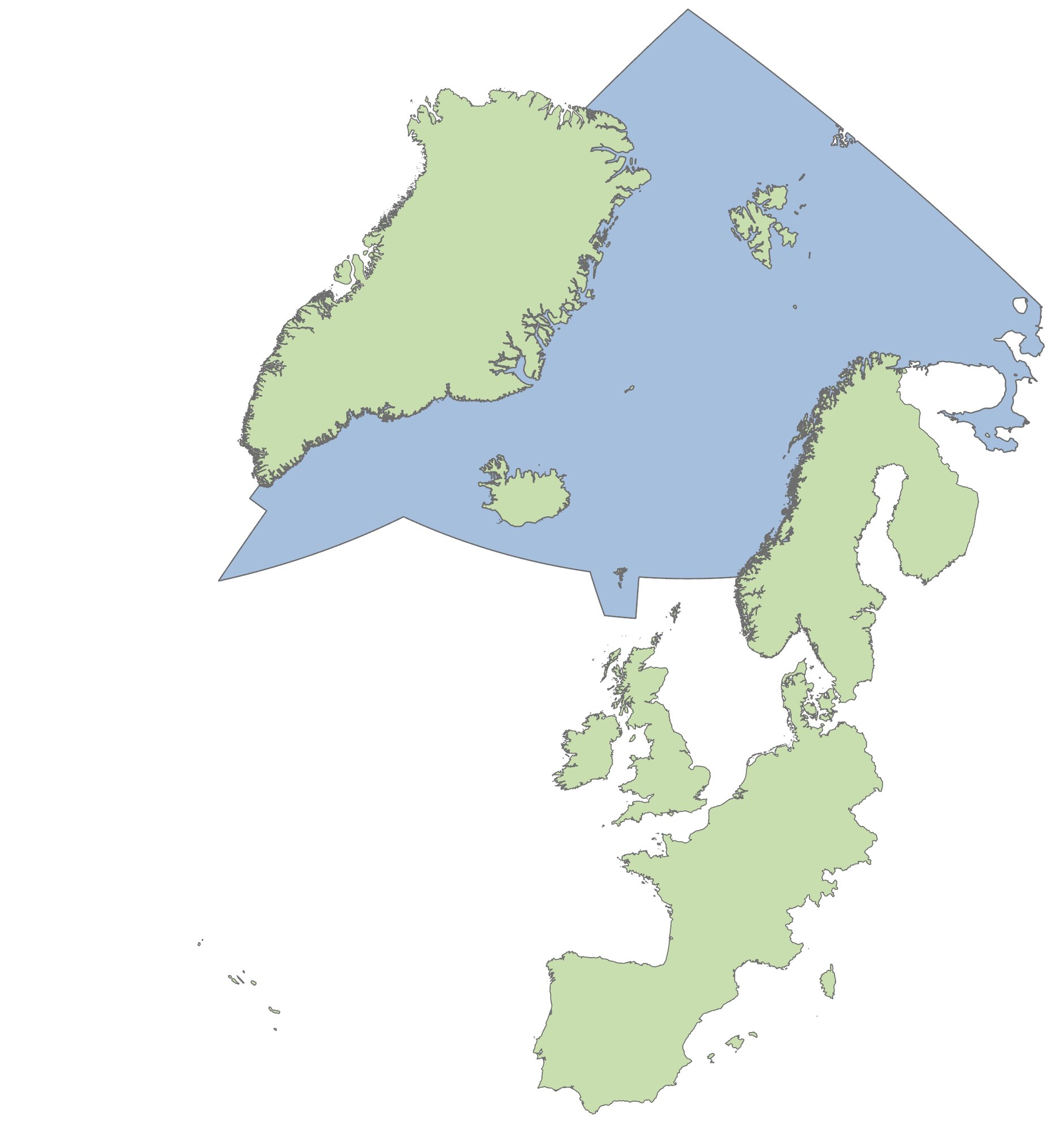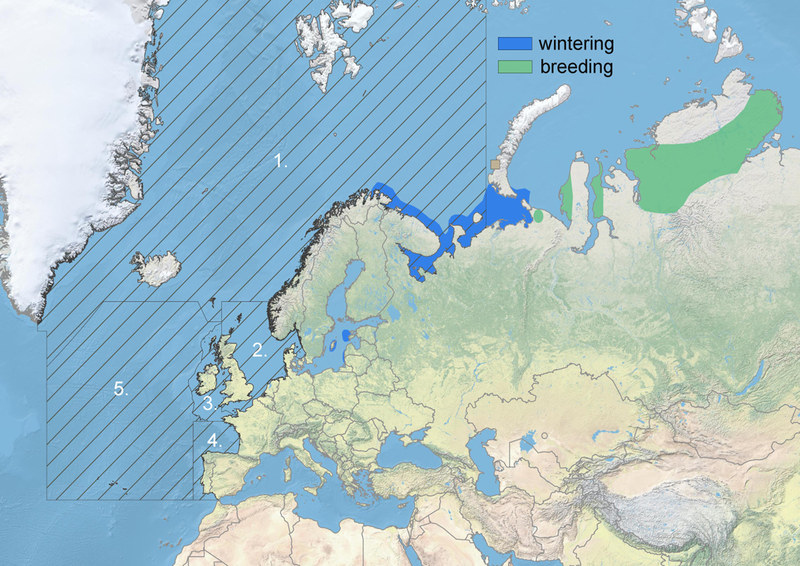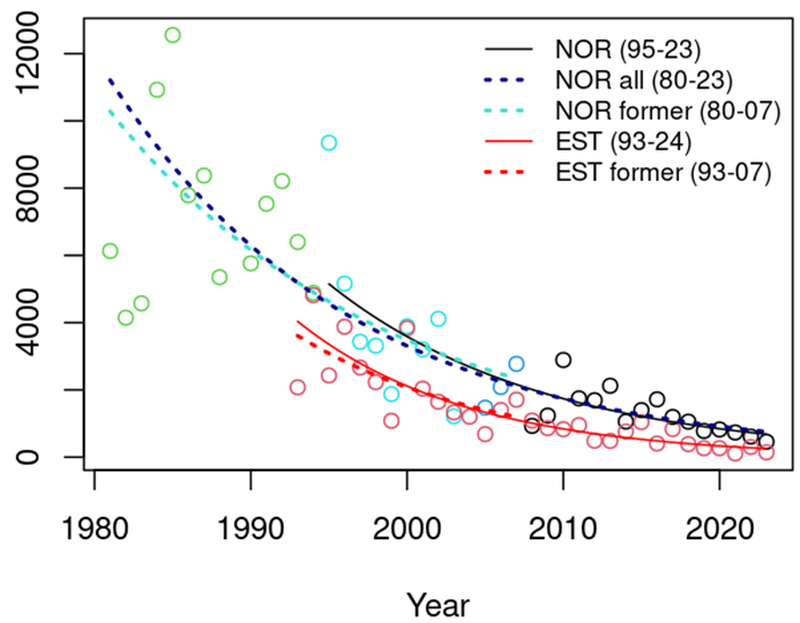Status Assessment 2025 - Steller’s eider
The global Steller’s eider Polysticta stelleri population is considered vulnerable (VU; IUCN Redlist - Assessed BirdLife International, 2018). There is a long-term negative trend for the wintering population within Arctic Waters (OSPAR Region I). The main causes for a declining wintering population may be a combination of general population decline, and a potential shift in wintering areas further north and east, that formerly were covered in ice during winter (Aarvak et al., 2012).

| Assessment of status | Non-breeding distribution | Non-Breeding population size | Breeding distribution | Breeding population size | Condition, i.e. breeding productivity | Evidence of Status | |
|---|---|---|---|---|---|---|---|
Region | I | ? | ↓1 | NA | NA | NA | ↓1 |
| II | |||||||
| III | |||||||
| IV | |||||||
| V | |||||||
| Outside | |||||||
Assessment of threats | Oil spill | Bycatch | Habitat destruction | Climate change | Hunting | Evidence of threat or impact | |
|---|---|---|---|---|---|---|---|
Region | I | ↑1,3 | ←→1 | ←→1 | ↑1 | ↑5 | ←→3 |
| II | |||||||
| III | |||||||
| IV | |||||||
| V | |||||||
Explanation to table:
Distribution, Population size, Condition
Trends in status (since the assessment in the background document)
↓ decreasing trend or deterioration of the criterion assessed
↑ increasing trend or improvement in the criterion assessed
←→ no change observed in the criterion assessed
? trend unknown in the criterion assessed
Previous status assessment: If in QSR 2010 then enter Regions where species occurs ( ○) and has been recognised by OSPAR to be threatened and/or declining (● ) based on Chapter 10 Table 10.1 and Table 10.2 . If a more recent status assessment is available, then enter ‘poor’/’good’
Status*(overall assessment)
red – poor
green – good
blue – ? status unknown
NA- Not Applicable
*applied to assessments of status of the feature or of a criterion, as defined by the assessment values used in the QSR 2023 or by expert judgement.
Key Pressure
↓ key pressures and human activities reducing
↑ key pressures and human activities increasing
←→ no change in key pressures and human activities
? Change in pressure and human activities uncertain
Threats or impacts (overall assessment)
red – significant threat or impact;
green–no evidence of a significant threat or impact
blue – insufficient information available
NA – not applicable
1 – direct data driven,
2 – indirect data driven,
3 – third party assessment close-geographic match,
4 - third party assessment partial-geographic match
5 – expert judgement.
Confidence
The status assessment is considered to have high confidence, due to the long-term count data used. The distribution of Steller’s Eider within OSPAR Region I is limited.
However, threat assessment has low confidence because of the lack of thorough quantification of threats, in addition to unresolved interaction effects, combined with potential effects from climate change.
Background Information
Year added to OSPAR list: 2003 (OSPAR 2003)
Global/regional importance: The entire breeding population of the Steller's Eider is located outside OSPAR Region I, see map below. However, OSPAR Region I Arctic waters hosts a proportion of the wintering population, historically 15-20%.
Decline: The Steller’s Eider wintering population has experienced a continuous decline for the past decades. Approximately, 75% decline in wintering Steller’s Eiders since 2002 (21 years/3 generations).
Sensitivity: Wintering Steller’s Eider are especially sensitive to oil pollution (i.e. oil spill) as they gather in dense flocks. Moreover, Steller’s Eider are subject to drowning in fishnets and habitat degradation.
Anthropogenic pressures and biological factors: All principal threats to the Steller’s Eider in the wintering area are related to human activities, see below under Threats.
Last status assessment: 2009. The former assessment evaluated that Steller’s Eider has regional importance, as a large proportion of the total known population winters within OSPAR Region I. Moreover, the species was assessed as suffering from several threats from human activities, and that potential recovery from adverse events would take a long time. Finally, the wintering population had experienced a severe decline (>50%) in the past. These concerns have been corroborated and even exacerbated in the present assessment. https://www.ospar.org/documents?v=7184
Geographical Range and Distribution
The breeding distribution of the Western population of Steller's eider is located from east of the Novaya Zemlya, in the areas Yamal and Taymyr (Figure 1). Within OSPAR Region I, along the Norwegian north coast, a proportion of the population spends the winter, in addition to the coast extending along Kola and eastwards (until areas covered in ice). Additionally, some of the population winters in the Baltic waters primarily outside Estonia.
The geographical wintering range may be shifting as a response to global warming and resulting disappearance of sea ice, hosting a larger proportion of the population outside the OSPAR area; however, proof or evidence is lacking. Also, data from the breeding areas within Russian territory is currently lacking.

Figure 1: Distribution of the Western Palearctic Steller’s eider Polysticta stelleri population. OSPAR regions are denoted with white text. The grey square indicates a potential breeding outside the regular breeding range (EBBA2).
Method of assessment: 2b, 3b.
Source: monitoring programs in Estonia and Norway, with contributory assessments from Finland, Sweden, Latvia and Lithuania.
Population/Abundance
Trends in the wintering population (Figure 2) underlines a dramatic decline in the number of wintering birds in OSPAR Region I, in fact increasing in strength since the last assessment. The trend of the wintering population in the Baltic Sea follows the same rate of decline (Table 1 and Figure 2).
| Previous trend | Current state | |||
|---|---|---|---|---|
| Annual decline ± SE | Years | Annual decline ± SE | Years | |
| OSPAR Region I and Baltic (Estonia) | 7.6 % ± 2.1 | 1993-2007 | 8.8 % ± 0.8 | 1993-2024 |
| Norway | 5.5 % ± 1.0 | 1980-2007 | 7.0 % ± 0.8 | 1995-2023 |

Figure 2: The number of wintering Steller’s Eider Polysticta stelleri along the Norwegian north-east coast during the period 1980-2023 (green, turquoise and blue represents older data from Norway), (black dots represents BirdLife Norway recent data), supplemented with survey data from Estonia (red dots). Note solid lines, indicating a steeper decline during the last three decades compared to knowledge from the last assessment (dotted lines).
Method of assessment: 3a
Source: Nygårdet al. 1995, Žydelis et al. 2006, Elts et al., 2019, Elts et al. unpublished data, Øien et al., 2024.
Condition
The wintering population of Steller’s Eider has experienced a severe decline within OSPAR Region I. However, the major underlying drivers for this decline are currently unknown. If most of the decline is associated with a general decline in the breeding population, immediate action is needed. Simultaneously, the wintering area for Steller’s Eider seems to have shifted northeast due to decline in sea ice, leading to a continuous decline in the proportion of wintering birds that are wintering within OSPAR Region I.
Method of assessment: 2b
Source: current literature, expert judgements, and indirect data.
Threats and Impacts
Threats seem to be continuing in OSPAR Region I, with the most important threats including drowning in fishing nets, oil pollution especially in key sites where large aggregation gather in dense flocks, and habitat degradation.
Threats to the breeding population, although outside OSPAR Region I, include oil and gas developments with its transportation, power lines, and thawing and changes to tundra breeding habitats due to climate change.
Measures that address key pressures from human activities or conserve the species/habitat
Steller’s Eider is currently listed as vulnerable (VU) on the international and national red lists respectively (BirdLife International, 2018; Stokkeet al., 2021). Norway and Estonia have monitoring programmes surveying the wintering populations.
Unfortunately, measures taken in the breeding areas are currently unknown.
Conclusion (including management considerations)
Current monitoring within the OSPAR Region I documents a long-term decline in the wintering population. Recent time series indicate a steeper decline compared to the trend from the last assessment (Table 1, Fig.2). In the Baltic Sea, monitoring in Estonia corroborates both the long-term trend and increased decline found in the OSPAR Region I. Whether declines in wintering population is a result of population decline in the breeding population or shifting wintering areas due to declines in sea ice during winter, is currently unknown.
Threats seem to be present and stable since the last OSPAR assessment. Pollution, especially oil spills, is a serious threat for congregations of wintering individuals. Other threats include bycatch, habitat destruction and illegal hunting. Also, collisions related to offshore wind farms and onshore powerlines, remain additional threats. Given that wintering populations are consistently declining, combined with prevailing threats within OSPAR Region I, Steller’s Eider is again justified for inclusion on the OSPAR List of Threatened and/or Declining Species and Habitats (Agreement 2008-06).
A conservation measure taken, is an assessment of winter distribution, in order to give robust information on risk areas of oil spill. However, more studies of individually tracked individuals can shed light on seasonal movement during winter.
Knowledge gaps
The assessment was based on counts of wintering individuals at one major wintering area within OSPAR Region I, and one outside the OSPAR Maritime Area, in the Baltic Sea. In the former assessment, aerial counts from a much larger area eastwards, along the northern coast of Kola peninsula was important in proving an eastward shift in wintering concentrations, likely due to less sea ice as an effect of climate change. The OSPAR Region I is covering only a part of the wintering population, so annual counts are not fully comparable.
Given an ongoing decline in wintering individuals, Steller’s Eider is projected to decline further within OSPAR Region I in the future.
Main source of information:
- The assessment is based on a mix of OSPAR data assessment and assessments from third parties.
Assessment is based upon:
- complete survey or a statistically robust estimate;
- the present status assessment is a continuation of the surveys used in the background document (OSPAR 2009). Thus, we use survey data from the national monitoring programs in Norway, supplemented by counts from the Baltic Sea, primarily Estonia.
Aarvak, T., Øien, I. J., Krasnov, Y. V., Gavrilo, M. V., & Shavykin, A. A. 2012. The European wintering population of Steller’s Eider Polysticta stelleri reassessed. Bird Conservation International, 23(3), 337–343. https://doi.org/10.1017/S0959270912000251
Bakken, V., & Strann, K.-B. (n.d.). The Steller’s Eider in Finnmark and Russia [Information sheet for the project «Bird tourism in central and eastern Finnmark», a project part of «The natural heritage as a value creator (M)»]. Bioforsk and Miljødirektoratet, Norway. Retrieved September 18, 2024, from https://www.nibio.no/tema/landskap/fugleturisme/_/attachment/inline/d808c1ac-1a72-471a-a829-9cb34f6d08f8:af698fd1878a2c205450495b4f5de7e5a766feab/Stellerand_Engelsk.pdf
Barrett, R. T. 1979. Small oil spill kills 10–20 000 seabirds in North Norway. Marine Pollution Bulletin, 10(9), 253–255. https://doi.org/10.1016/0025-326X(79)90479-X
BirdLife International. 2018. Polysticta stelleri. The IUCN Red List of Threatened Species 2018. IUCN Red List of Threatened Species, e.T22680415A132527232. https://doi.org/10.2305/IUCN.UK.20182.RLTS.T22680415A132527232.en
Bustnes, J. O., & Systad, G. H. 2001. Habitat use by wintering Steller’s Eiders Polysticta stelleri in northern Norway. Ardea, 89(2), 267–274.
Dagys, M., & Žydelis, R. 2002. Bird Bycatch in Fishing Nets in Lithuanian Coastal Waters in Wintering Season 2001–2002. Acta Zoologica Lituanica, 12(3), 276–282. https://doi.org/10.1080/13921657.2002.10512514
Elts, J., Leito, A., Leivits, M., Luigujõe, L., Nellis, R., Ots, M., Tammekänd, I., & Väli, Ü. 2019. Eesti lindude staatus, pesitsusaegne ja talvine arvukus 2013–2017.
Hirundo, 32(1), 1–39.
Fox, A. D., Mitchell, C., Henriksen, G., Lund, E., & Frantzen, B. 1997. The conservation of Steller’s Eider Polysticta stelleri in Varangerfjord, Finnmark, Norway. Wildfowl, 48, 156–165.
Frantzen, B., & Henriksen, G. 1992. Stelleranda i Finnmark. Fauna, 100–107.
Grastveit, J. 1975. Vask av oljeskadet fugl. Lappmeisen, 22–25.
Heggøy, O., Øien, I. J., & Aarvak, T. 2019. Winter distribution of Steller’s Eiders in the Varangerfjord, northern Norway. Ornis Norvegica, 42, 1–6. https://doi.org/10.15845/on.v42i0.2581
Mineev, O., Mineev, Y., Kochanov, S., & Novakovskiy, A. 2023. Population Status of the Globally Threatened Long-Tailed Duck Clangula hyemalis in the Northeast European Tundra. Diversity, 15, 666. https://doi.org/10.3390/d15050666
Nygård, T., Frantzen, B., & Švažas, S. 1995. Steller’s Eiders Polysticta stelleri wintering in Europe: Numbers, distribution and origin. Wildfowl, 46, 140-155.
Quakenbush, L., Suydam, R., Obritschkewitsch, T., & Deering, M. 2004. Breeding Biology of Steller’s Eiders (Polysticta stelleri) near Barrow, Alaska, 1991 – 99. Arctic, 57(2), 166–182.
Stokke, B. G., Dale, S., Jacobsen, K.-O., Lislevand, T., Solvang, R., & Strøm, H. 2021. Fugler Aves – Norge. I: Artsdatabanken. 2021. (Norsk rødliste for arter 2021.). Artsdatabanken. https://artsdatabanken.no/rodlisteforarter2021/Artsgruppene/fugler
U.S. Fish and Wildlife Service. 2002. Steller’s Eider Recovery Plan. https://endangered.fws.gov/http://alaska.fws.gov/es/te.cfm
Žydelis, R., Bellebaum, J., Österblom, H., Vetemaa, M., Schirmeister, B., Stipniece, A., Dagys, M., van Eerden, M., & Garthe, S. 2009. Bycatch in gillnet fisheries—An overlooked threat to waterbird populations. Biological Conservation, 142(7), 1269–1281. https://doi.org/10.1016/j.biocon.2009.02.025
Žydelis, R., Lorentsen, S.-H., Fox, A. D., Kuresoo, A., Krasnov, Y., Goryaev, Y., Bustnes, J. O., Hario, M., Nilsson, L., & Stipniece, A. 2006. Recent changes in the status of Steller’s Eider Polysticta stelleri wintering in Europe: A decline or redistribution? Bird Conservation International, 16(3), 217–236. https://doi.org/10.1017/S0959270906000360
Øien, I. J., Aarvak, T., & Heggøy, O. 2024. Sårbare stellerender i Varangerfjorden.
Vår Fuglefauna, 47 (2024–01), 20–24.
Sheet reference:
BDC2025/Steller's_eider


